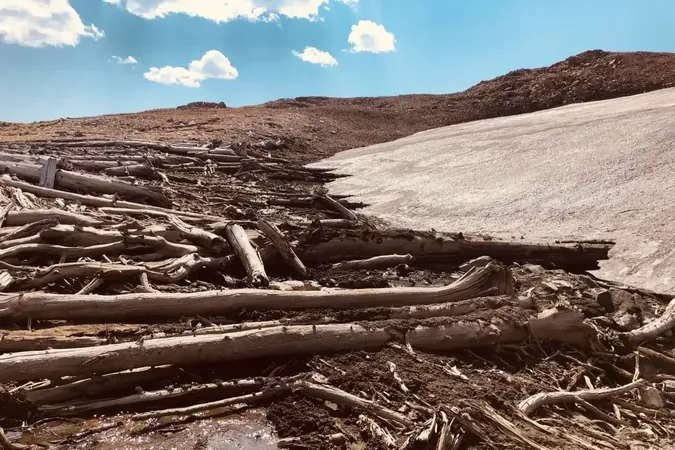
Ancient Secrets Unveiled: A 6,000-Year-Old Forest Discovered in the Rocky Mountains — What Does It Mean for Our Future?
2025-01-19
Author: Benjamin
Ancient Secrets Unveiled
The relentless warmth of climate change has revealed astonishing secrets hidden in the Rocky Mountains — a 5,900-year-old whitebark pine forest has come to light, transforming our understanding of the region's ancient ecology.
Discovery in the Beartooth Plateau
Recently, scientists conducting an archaeological survey on the Beartooth plateau in Wyoming stumbled upon the remains of over 30 trees, astonishingly situated at 3,100 meters above sea level, far beyond the current tree line. This groundbreaking discovery provides incredible insights into climatic conditions from millennia ago.
Significance of the Finding
Cathy Whitlock, a prominent researcher from Montana State University, emphasizes the importance of this finding: "This find offers us a rare look into past conditions at high elevations. Currently, you won't see Whitebark pine (Pinus albicaulis) thriving at this altitude due to cooler climate conditions." Researchers determined that these trees flourished around 5,950 to 5,440 years ago, during a time of gradual temperature decline. By examining the tree rings and leveraging carbon dating techniques, the team pieced together the forest's timeline.
Understanding the Temperature Drop
But what triggered this significant temperature drop? The answers may lie in the polar regions. Ice core studies from Antarctica and Greenland indicate that centuries of volcanic activity in the northern hemisphere played a critical role in cooling the planet. Eruptions released ash and sediment into the atmosphere, blocking sunlight and contributing to a gradual decline in temperatures that eventually rendered conditions too harsh for the forest to survive.
Support for the Theory
Joe McConnell from the Desert Research Institute in Nevada supports this theory, stating that "climate models indicate a significant temperature drop around 5,100 years ago, primarily due to ongoing volcanic eruptions in Iceland."
Preservation of the Ancient Trees
Closer inspection of the fallen trees revealed they remained in exceptional condition, likely preserved by the thick ice that entombed them. Though there is insufficient evidence to confirm that avalanche coverage played a role, marks on the trees correspond to the expansion of the current ice patch. McConnell noted, "These trees were protected from the elements for almost 5,000 years as the ice patch grew due to the colder temperatures."
Implications of Melting Ice
The melting ice that allowed these ancient remnants to reemerge is a stark reminder of the effects of rising temperatures. As the climate continues to warm, Whitlock anticipates that "the current tree line is likely to shift upslope in the coming decades." She poignantly adds, "This discovery exemplifies how anthropogenic climate change is exposing landscapes that have been buried under ice for thousands of years. While these findings are scientifically invaluable, they also highlight the vulnerability of alpine ecosystems in the face of climate change."
Valuable Time Capsule
Kevin Anchukaitis from the University of Arizona has dubbed this forest a "valuable time capsule," revealing not just harsh old environments, but the climatic conditions that enabled them to thrive. This isn't the first time the Rockies have yielded ancient artifacts; past discoveries include wooden shafts used by prehistoric hunters, with one dating back over 10,000 years, proving that humans have hunted in high-elevation areas for thousands of years.
Conclusion: A Call to Awareness
As the world grapples with the realities of climate change, each discovery in these melting ice patches serves as a warning and a testament to the intricate history our planet holds. What will the next revealing layer of ice uncover? Only time will tell.









 Brasil (PT)
Brasil (PT)
 Canada (EN)
Canada (EN)
 Chile (ES)
Chile (ES)
 Česko (CS)
Česko (CS)
 대한민국 (KO)
대한민국 (KO)
 España (ES)
España (ES)
 France (FR)
France (FR)
 Hong Kong (EN)
Hong Kong (EN)
 Italia (IT)
Italia (IT)
 日本 (JA)
日本 (JA)
 Magyarország (HU)
Magyarország (HU)
 Norge (NO)
Norge (NO)
 Polska (PL)
Polska (PL)
 Schweiz (DE)
Schweiz (DE)
 Singapore (EN)
Singapore (EN)
 Sverige (SV)
Sverige (SV)
 Suomi (FI)
Suomi (FI)
 Türkiye (TR)
Türkiye (TR)
 الإمارات العربية المتحدة (AR)
الإمارات العربية المتحدة (AR)